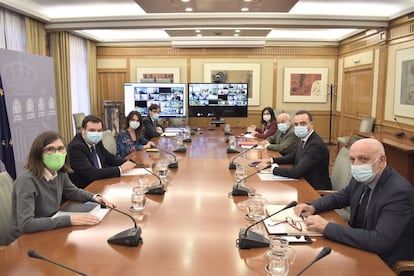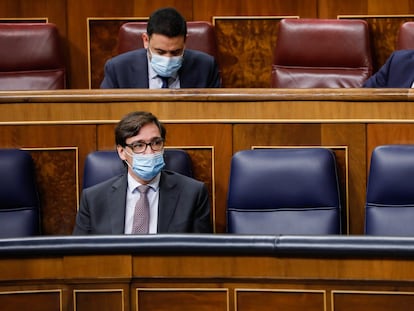Spain’s new coronavirus alert system shows four regions at ‘extreme risk’ level
A draft project that must still be discussed with regional officials aims to clarify the criteria for adopting restrictions on mobility

The Spanish Health Ministry is working with regional governments on a coronavirus alert system aimed at clarifying the measures that should be taken to contain the epidemic, depending on the risk level in each territory. The system still leaves the decision to introduce mandatory confinement in the hands of regional authorities.
The draft project, which EL PAÍS has seen, establishes a four-level system based on several metrics to determine the risk level in municipalities with populations of over 5,000. Depending on how locations rank on these indicators, their assigned risk level could be low, moderate, high or extreme.
Four regions at ‘extreme risk’
Based on the latest available public data, there are at least four regions of Spain in the highest risk level of all: Aragón, Castilla y León, Madrid and La Rioja. The exclave city of Ceuta, located on the northern coast of Africa, also falls into the extreme risk category.
According to this newspaper’s calculations, the regions in the next risk category (high) are Castilla-La Mancha, Catalonia, Murcia, Navarre and the Basque Country, besides Spain’s other exclave city in North Africa, Melilla.
Andalusia, Asturias, the Balearic and Canary archipelagos, the Valencia region and Extremadura show moderate risk, while Cantabria and Galicia would be classified as low risk based on the draft’s parameters. No region is completely out of danger.
Specific measures
The new alert system could help guide health officials’s decisions on mobility restrictions and social-distancing rules. The draft, which still has be to discussed with regional authorities, establishes specific measures for municipalities in each level.
There is no mandatory confinement in any of the risk levels, but the extreme risk category entails “exceptional measures” that could include “limiting personal mobility, containment with perimeter control, and other restrictions on movement.”
At the third level (high risk), the limitations are similar to what is already being done in high-transmission areas: social meetings limited to no more than six people, capacity at bars and restaurants reduced to 50% and down to 30% on public transit, and remote working whenever possible, among other measures.
Two sets of parameters
In order to calculate the risk, two sets of parameters are used. The first set attempts to measure coronavirus transmission using six metrics: the 14-day and the seven-day cumulative incidence per 100,000 people, the same two indicators applied exclusively to the 65-and-over population, the positivity rate (amount of tests that come back positive out of the total) and the percentage of cases that can be traced back to the source of infection.
The second set measures the healthcare system’s ability to cope with the crisis in terms of regular hospital beds and intensive care beds occupied by Covid-19 patients.
Each indicator is assigned a value. The threshold for extreme risk is a 14-day cumulative incidence of more than 250 cases per 100,000 people, and a seven-day incidence of 125. These figures fall to 150 and 75 for the 65-and-over population. A positivity rate of 15% and a traceability of under 10% are also considered hallmarks of extreme risk.
In the second set of parameters, extreme risk is defined by more than 20% of regular hospital beds and more than 25% of intensive care beds occupied by Covid-19 patients.
When a territory has two or more indicators from the first set and at least one indicator from the second set above these thresholds, it is considered to be in the extreme risk category.
Lack of common criteria
A lack of common criteria has been apparent in the fight against the coronavirus. From the beginning of the crisis, the Health Ministry has been avoiding publishing epidemiological thresholds on which to base health policy decisions, which are devolved to the regions.
This has yielded situations like the one on display in Madrid, where central and regional authorities have been locked in a political and legal battle over how best to deal with the health crisis while saving the economy. The central government ultimately imposed a 15-day state of alarm in the region, saying Madrid authorities were not doing enough to contain transmission.
English version by Susana Urra.
Tu suscripción se está usando en otro dispositivo
¿Quieres añadir otro usuario a tu suscripción?
Si continúas leyendo en este dispositivo, no se podrá leer en el otro.
FlechaTu suscripción se está usando en otro dispositivo y solo puedes acceder a EL PAÍS desde un dispositivo a la vez.
Si quieres compartir tu cuenta, cambia tu suscripción a la modalidad Premium, así podrás añadir otro usuario. Cada uno accederá con su propia cuenta de email, lo que os permitirá personalizar vuestra experiencia en EL PAÍS.
¿Tienes una suscripción de empresa? Accede aquí para contratar más cuentas.
En el caso de no saber quién está usando tu cuenta, te recomendamos cambiar tu contraseña aquí.
Si decides continuar compartiendo tu cuenta, este mensaje se mostrará en tu dispositivo y en el de la otra persona que está usando tu cuenta de forma indefinida, afectando a tu experiencia de lectura. Puedes consultar aquí los términos y condiciones de la suscripción digital.
More information
Últimas noticias
Most viewed
- Reinhard Genzel, Nobel laureate in physics: ‘One-minute videos will never give you the truth’
- Oona Chaplin: ‘I told James Cameron that I was living in a treehouse and starting a permaculture project with a friend’
- Pablo Escobar’s hippos: A serious environmental problem, 40 years on
- Charles Dubouloz, mountaineering star, retires at 36 with a farewell tour inspired by Walter Bonatti
- Why we lost the habit of sleeping in two segments and how that changed our sense of time










































